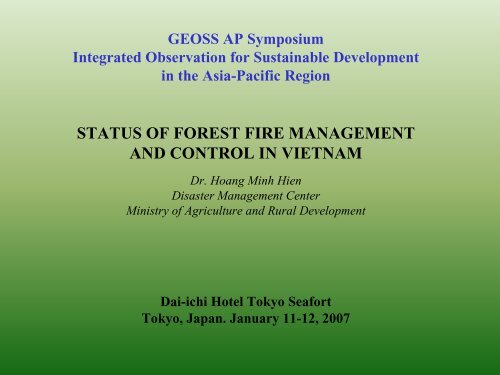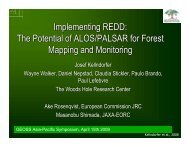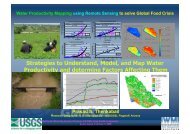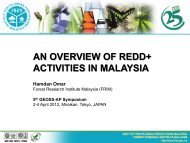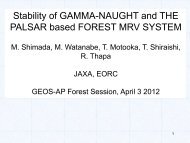Causes of Forest Fire in Vietnam
Causes of Forest Fire in Vietnam
Causes of Forest Fire in Vietnam
Create successful ePaper yourself
Turn your PDF publications into a flip-book with our unique Google optimized e-Paper software.
GEOSS AP Symposium<br />
Integrated Observation for Susta<strong>in</strong>able Development<br />
<strong>in</strong> the Asia-Pacific Region<br />
STATUS OF FOREST FIRE MANAGEMENT<br />
AND CONTROL IN VIETNAM<br />
Dr. Hoang M<strong>in</strong>h Hien<br />
Disaster Management Center<br />
M<strong>in</strong>istry <strong>of</strong> Agriculture and Rural Development<br />
Dai-ichi Hotel Tokyo Seafort<br />
Tokyo, Japan. January 11-12, 2007
STATUS OF FOREST FIRE MANAGEMENT<br />
AND CONTROL IN VIETNAM<br />
Situation <strong>of</strong> <strong>Forest</strong> <strong>Fire</strong><br />
+ Total <strong>Forest</strong> area: about 12,094,518ha<br />
+ Natural <strong>Forest</strong> area: about 10,004,709ha (82.7%)<br />
+ Plantation <strong>Forest</strong> area: about 2,089,809ha (17.3%)<br />
In dry season there are about 6 millions ha <strong>of</strong> forest<br />
and plant vegetable (about 50% <strong>of</strong> total forest area) with<br />
high potential <strong>of</strong> forest fire risk, located <strong>in</strong> 48 different<br />
prov<strong>in</strong>ces and cities.<br />
<strong>Forest</strong> types, which easy to catch fire <strong>in</strong>clud<strong>in</strong>g: p<strong>in</strong>e,<br />
dipterocarpaceac, <strong>in</strong>digo, casuar<strong>in</strong>as, eucalyptus,<br />
bamboo forest, grassland and brush trees. However,<br />
when severe weather and climate com<strong>in</strong>g, all the forest<br />
types could easy cast fire and forest fire happen <strong>in</strong> high<br />
frequency.
Weather and climate condition are differ from zone to other<br />
zone <strong>in</strong> <strong>Vietnam</strong>. The forest fire could happen at any time<br />
around the year <strong>in</strong> different locations.<br />
- In average, from December <strong>of</strong> previous year to April <strong>of</strong><br />
the next year is a forest fire season with high risk <strong>in</strong><br />
different eco-regions: North-East, North-West, Plateau,<br />
East <strong>of</strong> Southern <strong>Vietnam</strong> and Mekong Delta River;<br />
- From June to August with dry and hot western w<strong>in</strong>d is<br />
a season <strong>of</strong> forest fire <strong>in</strong> Northern part <strong>of</strong> Middle<br />
<strong>Vietnam</strong>;<br />
- From April to June is a season <strong>of</strong> forest fire <strong>in</strong> Coastal<br />
Prov<strong>in</strong>ces <strong>of</strong> Central Middle <strong>Vietnam</strong>.<br />
There is quite strong relationship between the total number<br />
<strong>of</strong> forest fires and ENSO activities. General speak<strong>in</strong>g, <strong>in</strong> El<br />
N<strong>in</strong>o period, the average number <strong>of</strong> forest fires <strong>in</strong> <strong>Vietnam</strong> is<br />
much more than <strong>in</strong> La N<strong>in</strong>a period.
Places and month <strong>of</strong> forest fire<br />
<strong>in</strong> different eco-regions <strong>in</strong> <strong>Vietnam</strong><br />
Note: (+) Drought month, danger <strong>of</strong> forest fire (-) Dry month, risk <strong>of</strong> forest fire
The Ma<strong>in</strong> Disaster Phenomenon <strong>in</strong> <strong>Vietnam</strong><br />
The ma<strong>in</strong> disaster risks <strong>in</strong> <strong>Vietnam</strong>, <strong>in</strong>clud<strong>in</strong>g forest fire,<br />
are showed as bellow:<br />
1. Storm & Storm Surge 8. River bank erosion<br />
2. Flood 9. Flash Flood<br />
3. Inundation 10. Landslide<br />
4. Drought 11. Earthquake<br />
5. Salt Invasion 12. Tsunami<br />
6. Whirlw<strong>in</strong>d 13. <strong>Forest</strong> fire<br />
7. Shorel<strong>in</strong>e Erosion 14. Other<br />
However, for <strong>Vietnam</strong>, the forest fire is not def<strong>in</strong>ed as a<br />
natural disaster.
Map <strong>of</strong> ma<strong>in</strong><br />
forest fire<br />
areas <strong>in</strong><br />
Northern<br />
<strong>Vietnam</strong>
Map <strong>of</strong> ma<strong>in</strong><br />
forest fire<br />
areas <strong>in</strong><br />
Southern<br />
<strong>Vietnam</strong>
Situation <strong>of</strong> <strong>Forest</strong> <strong>Fire</strong>s over last 12 year<br />
(1992-2003)
<strong>Forest</strong> fire status quo <strong>in</strong> <strong>Vietnam</strong><br />
Areas (ha)<br />
12.000<br />
10.000<br />
8.000<br />
6.000<br />
4.000<br />
2.000<br />
-<br />
Nature forest<br />
Plantation forest<br />
1992<br />
1994<br />
1996<br />
1998<br />
2000<br />
2002<br />
Years
<strong>Causes</strong> <strong>of</strong> <strong>Forest</strong> <strong>Fire</strong> <strong>in</strong> <strong>Vietnam</strong><br />
1. Burn<strong>in</strong>g for agriculture land by ethnic m<strong>in</strong>orities; straw<br />
and grass burn<strong>in</strong>g <strong>in</strong> rice field. The forest fires caus<strong>in</strong>g by<br />
this k<strong>in</strong>d <strong>of</strong> reason takes about 20% <strong>of</strong> total forest fires.<br />
2. Local people us<strong>in</strong>g fire for hunt<strong>in</strong>g, trapp<strong>in</strong>g and<br />
catch<strong>in</strong>g wild animals <strong>in</strong> forest, especially use <strong>of</strong> smoke to<br />
harvest bee’s honey (about 55%).<br />
3. Illegal activities <strong>of</strong> timber, wood and other forest<br />
products exploitation, they us<strong>in</strong>g fire without take<br />
consideration when cook<strong>in</strong>g, smok<strong>in</strong>g etc. (about 15% ).<br />
4. The trad<strong>in</strong>g conflict from forest resource exploitation <strong>of</strong><br />
stakeholders with burn<strong>in</strong>g forest to harm other competitors<br />
(about 10%).<br />
General speak<strong>in</strong>g, the human activities are the major<br />
causes <strong>of</strong> forest and grassland fires <strong>in</strong> <strong>Vietnam</strong>.
Solution and Direction on Prevention<br />
and Fight<strong>in</strong>g aga<strong>in</strong> <strong>Forest</strong> <strong>Fire</strong><br />
1. The mode <strong>of</strong> <strong>Forest</strong> <strong>Fire</strong> Prevent<strong>in</strong>g and Fight<strong>in</strong>g<br />
- Concentrate <strong>in</strong> fire prevention; strengthen<strong>in</strong>g <strong>of</strong> forest fire<br />
forecast and warn<strong>in</strong>g;<br />
- Regular check<strong>in</strong>g and control <strong>of</strong> forest fire <strong>in</strong> dry season.<br />
- Implement <strong>of</strong> method <strong>of</strong> “4 Spots at Site”: use <strong>of</strong> local<br />
force, local equipment, local logistics and command at<br />
local site.<br />
- Detection <strong>of</strong> forest fire at the beg<strong>in</strong>n<strong>in</strong>g stage.<br />
- Improve the role and duty <strong>of</strong> forest fire prevention and<br />
fight<strong>in</strong>g to forest owner <strong>of</strong> area allocated by government.<br />
- Improve the cooperation between different forces, especially<br />
forest ranger, army and police… under direct guidel<strong>in</strong>e and<br />
comprehensive <strong>of</strong> local government <strong>in</strong> forest fire fight<strong>in</strong>g.
2. Ma<strong>in</strong> Solutions<br />
To implement the above-mentioned guidel<strong>in</strong>e, the Local<br />
Government and related forest protection units from<br />
different levels have to carry out activities as bellow:<br />
- Improve the quality <strong>of</strong> setup and implement the plann<strong>in</strong>g,<br />
aspects and project <strong>of</strong> forest fire prevent<strong>in</strong>g and fight<strong>in</strong>g<br />
- Improve the knowledge and awareness <strong>of</strong> local people<br />
and agencies, schools... about the forest fire prevent<strong>in</strong>g<br />
and fight<strong>in</strong>g<br />
- Strictly direction on forest fire prevent<strong>in</strong>g & fight<strong>in</strong>g to<br />
forest owners.<br />
- Strictly <strong>in</strong>spection <strong>of</strong> the forest fire prevent<strong>in</strong>g and<br />
fight<strong>in</strong>g <strong>of</strong> forest at localities.
Some Activities and New Applications for<br />
<strong>Forest</strong> <strong>Fire</strong> Management & Control <strong>in</strong> <strong>Vietnam</strong>
1. <strong>Forest</strong> <strong>Fire</strong> Risk Warn<strong>in</strong>g<br />
The <strong>Forest</strong> Protection Department (FPD) belong<strong>in</strong>g to the<br />
M<strong>in</strong>istry <strong>of</strong> Agriculture and Rural Development (MARD) has<br />
developed a National <strong>Fire</strong> Danger Rat<strong>in</strong>g.<br />
• <strong>Fire</strong>-related weather data is collected for analysis <strong>of</strong> a forest<br />
fire danger rates for distribution across the country.<br />
• The fire danger rat<strong>in</strong>g that is made available <strong>in</strong> rural areas via<br />
different media <strong>in</strong>clud<strong>in</strong>g facsimile, radio, television and<br />
roadside signboards.<br />
• FPD then have created special s<strong>of</strong>tware which us<strong>in</strong>g the<br />
Nesterop algorithm to calculate the levels <strong>of</strong> forest fire risk <strong>of</strong><br />
all prov<strong>in</strong>ces. The result <strong>of</strong> calculated the immediately<br />
transfer to <strong>Vietnam</strong> Radio Voice and <strong>Vietnam</strong> Television for<br />
broadcast.<br />
• The forest fire forecast also f<strong>in</strong>d <strong>in</strong> the web <strong>of</strong> FPD and<br />
MARD: http://www.kiemlam.org.vn<br />
http://kiemlam.mard.gov.vn
S<strong>of</strong>tware for calculation Levels <strong>of</strong> <strong>Forest</strong> <strong>Fire</strong> Risk<br />
Use <strong>of</strong> meteorological data for estimate the levels <strong>of</strong><br />
forest fire risk<br />
Station<br />
Name<br />
T 0 13 Humidity (%) Ra<strong>in</strong>fall (mm)
Designat<strong>in</strong>g <strong>of</strong> forest fire forecast, follow<strong>in</strong>g the<br />
Nesterrop’s Formula to calculate the P <strong>in</strong>dicator<br />
P = k *<br />
n<br />
∑<br />
i=<br />
1<br />
T13i<br />
* D13i<br />
<strong>in</strong> which:<br />
k = 0 when ra<strong>in</strong>fall >= 5mm or 3 cont<strong>in</strong>uous days <strong>of</strong> ra<strong>in</strong><strong>in</strong>g,<br />
k = 1 if the ra<strong>in</strong> fall < 5mm<br />
N is a number <strong>of</strong> days without ra<strong>in</strong><strong>in</strong>g<br />
T13i is the temperature at 13 o'clock <strong>in</strong> i day<br />
D13i is the differential saturated between dry graph and wet<br />
graph <strong>of</strong> day i (calculated from T13i and humidity <strong>of</strong> day i)
The chart <strong>of</strong> forest fire forecast<br />
Factors:<br />
-T o 13 at 13h<br />
- Humidity at 13h<br />
- D13 (present <strong>in</strong> the<br />
table)<br />
- n: No <strong>of</strong> dry days<br />
.....<br />
Computerization<br />
Comb<strong>in</strong>ed<br />
with the<br />
map<br />
Website<br />
Mass<br />
media
The value <strong>of</strong> P co-efficient is use to identify the levels<br />
<strong>of</strong> forest fire risk, which depend on the decision <strong>of</strong><br />
prov<strong>in</strong>cial people committee, for example:<br />
Prov<strong>in</strong>ce Level 1 Level 2 Level 3 Level 4<br />
Quang N<strong>in</strong>h 2.500 5.000 7.500 10.000<br />
Tay nguyen 5.000 10.000 15.000 20.000<br />
...... ...... .... ..... ....
Level 3, 4 and 5: are for automatically<br />
filled color on map at the district level.<br />
- Level 3: It is danger for forest fire, which is<br />
presented <strong>in</strong> yellow color. In this case is<br />
needed to consider on forest fire prevention<br />
for p<strong>in</strong>e, eucalyptus, bamboo, rubber and<br />
<strong>in</strong>digo forest etc.<br />
- Level 4: It is very danger <strong>of</strong> forest fire,<br />
which is presented <strong>in</strong> orange color. It is a<br />
high risk <strong>of</strong> forest fire <strong>in</strong> large scale.<br />
- Level 5: Dramatically danger <strong>of</strong> strong<br />
forest fire <strong>in</strong> large scale with quick<br />
spread<strong>in</strong>g. It is presented <strong>in</strong> red color,<br />
which mostly happen <strong>in</strong> drought season.<br />
3 4 5
Some effective results on use <strong>of</strong> TV and Radio<br />
for show <strong>of</strong> places and levels <strong>of</strong> forest fire risk<br />
- Improve the awareness and knowledge for people, especially<br />
the local communities who liv<strong>in</strong>g near the forest understand <strong>of</strong><br />
forest fire prevention and fight<strong>in</strong>g.<br />
- To warn the forest owners, local government strengthen<strong>in</strong>g all<br />
the measures to prevent and fight aga<strong>in</strong> the forest fire.<br />
Although there are some advantage but also still some<br />
disadvantage <strong>of</strong> new method <strong>in</strong> us<strong>in</strong>g <strong>in</strong>formation technology<br />
and remote sens<strong>in</strong>g:<br />
- The forest fire <strong>in</strong>dex limited is too old (<strong>in</strong>dex p <strong>in</strong> Nesterop<br />
algorithm), this <strong>in</strong>dex from prov<strong>in</strong>ces was established s<strong>in</strong>ce<br />
1992, and not suitable with the chang<strong>in</strong>g <strong>of</strong> climate <strong>in</strong> recently<br />
years.<br />
- The daily <strong>Forest</strong> fire forecast just only show the weather<br />
conditions with high risk <strong>of</strong> fire (warm<strong>in</strong>g) at certa<strong>in</strong> day but<br />
not able to predict the situation <strong>of</strong> forest risk <strong>in</strong> the next few<br />
day, or few week.
2. Early Detection <strong>of</strong> <strong>Forest</strong> <strong>Fire</strong> Spots<br />
FPD <strong>in</strong> cooperation with Centre <strong>of</strong> Remote Sens<strong>in</strong>g and GIS<br />
<strong>in</strong> order to apply <strong>of</strong> technology to early detect<strong>in</strong>g <strong>of</strong> forest<br />
fire. After NOAA data process<strong>in</strong>g, the result <strong>of</strong> hot spots will<br />
be sent to FPD at 6 pm each day. In turn, FPD will cont<strong>in</strong>ue<br />
to analyze the data <strong>in</strong> specific method:<br />
- Overlapp<strong>in</strong>g the fire map <strong>in</strong>to forest map to separate the fire<br />
spots outside forest and fire spots with reliability smaller than<br />
75%.<br />
- Identify the name <strong>of</strong> prov<strong>in</strong>ce, district and village have forest<br />
fire spots<br />
- Post the forest fire <strong>in</strong>formation onto website.<br />
- Make warn<strong>in</strong>g message to Prov<strong>in</strong>cial FPD to urgent they to<br />
implement the suitable measure aga<strong>in</strong> forest fire.<br />
However, due to the resolution <strong>of</strong> NOAA satellite picture are<br />
low (1km x 1km) and weather condition reasons, the result <strong>of</strong><br />
picture process<strong>in</strong>g not really good.
Meteorological<br />
station<br />
Meteorological<br />
station<br />
100 Meteorological station <strong>in</strong> the<br />
whole country Which belong to M<strong>in</strong>istry<br />
<strong>of</strong> Nature resources and Environment<br />
Meteorological<br />
station<br />
Email<br />
Chart <strong>of</strong> <strong>in</strong>formation exchange<br />
Broadcast <strong>of</strong><br />
forest fire<br />
news<br />
Email<br />
Centre <strong>of</strong><br />
Meteorological<br />
Email<br />
Broadcast<br />
<strong>of</strong> forest<br />
fire news<br />
<strong>Vietnam</strong><br />
Television<br />
Email<br />
<strong>Forest</strong><br />
Protection<br />
Department<br />
Email<br />
Radio the voice<br />
<strong>Vietnam</strong>
<strong>Forest</strong> <strong>Fire</strong> Warn<strong>in</strong>g on 8 th February 2004<br />
<strong>in</strong> Southern <strong>Vietnam</strong>
Shortcom<strong>in</strong>gs and suggestion<br />
• Lack <strong>of</strong> meteorological stations <strong>in</strong> some sensitive area <strong>of</strong><br />
forest fire<br />
• The resolution <strong>of</strong> map for forest fire status, management and<br />
warn<strong>in</strong>g is not good enough<br />
• Improvement <strong>of</strong> forest fire forecast procedure by use <strong>of</strong><br />
meteorological data and <strong>in</strong> comb<strong>in</strong>ation <strong>of</strong> estimation<br />
<strong>in</strong>formation extracted from satellite data<br />
• Sett<strong>in</strong>g up the MODIS Data Receiv<strong>in</strong>g Station. Detection <strong>of</strong><br />
hot spots by MODIS data receiv<strong>in</strong>g <strong>in</strong> real time.<br />
• Development and identification <strong>of</strong> forest fire risk levels<br />
separately for each concrete region <strong>of</strong> country<br />
• Prov<strong>in</strong>cial FPDs have to applied above-mentioned forest fire<br />
forecast procedure by themselves then notify the forest fire<br />
risk level for each district and for Prov<strong>in</strong>cial Television Media
Some Remarks on Use <strong>of</strong> RS Data for Hot Spots<br />
and <strong>Forest</strong> <strong>Fire</strong> Management <strong>in</strong> <strong>Vietnam</strong><br />
S<strong>in</strong>ce 90’s years <strong>of</strong> last century, there were some studies<br />
on use <strong>of</strong> NOAA data for detection <strong>of</strong> hot spots. The first<br />
pilot project on use <strong>of</strong> NOAA data on hot spots detection for<br />
forest fire management conducted <strong>in</strong> FPD, MARD s<strong>in</strong>ce<br />
2002.<br />
However, the accuracy and effectiveness <strong>of</strong> this pilot<br />
project has been not good enough to fit with the forest fire<br />
monitor<strong>in</strong>g and management <strong>in</strong> practice.<br />
The first MODIS satellite receiv<strong>in</strong>g station was<br />
established at VAST <strong>in</strong> 2001 and up to now it is only once<br />
MODIS receiv<strong>in</strong>g station <strong>in</strong> <strong>Vietnam</strong>.<br />
In last few years, there are some researches on use <strong>of</strong><br />
MODIS data for hot spots detection <strong>in</strong> <strong>Vietnam</strong>. However,<br />
up to now, there is no application <strong>of</strong> MODIS data <strong>in</strong><br />
practice for detection <strong>of</strong> hot spots and forest fire control yet.
Some Limitations on Use <strong>of</strong> Remote Sens<strong>in</strong>g Data<br />
<strong>in</strong> Practice for <strong>Forest</strong> <strong>Fire</strong>s Control<br />
• The MODIS data is not available at responsible <strong>in</strong>stitutions<br />
on forest fire management yet.<br />
• Lack <strong>of</strong> experts on application <strong>of</strong> RS data for forest fire<br />
detection, forecast and warn<strong>in</strong>g.<br />
• The number <strong>of</strong> hot spots detected by RS data is <strong>of</strong>ten over<br />
estimated. The test <strong>of</strong> hot spots at sites <strong>of</strong> forest fire is not<br />
convenience and expensive.<br />
• Mostly the forest fires <strong>in</strong> <strong>Vietnam</strong> are at small size while<br />
the space and frequency resolution <strong>of</strong> NOAA and MODIS<br />
data are not so high.<br />
• Hot spots detection by RS data is available at <strong>in</strong>ternational<br />
centers. However, mostly are only for the Southern<br />
<strong>Vietnam</strong>.<br />
• The comb<strong>in</strong>ation <strong>of</strong> RS with climate and meteorological<br />
data is not good enough.
Plan for use <strong>of</strong> MODIS data for Monitor<strong>in</strong>g<br />
<strong>of</strong> <strong>Forest</strong> Dynamic and <strong>Forest</strong> <strong>Fire</strong> Control<br />
• MARD is planned to setup the MODIS Satellite Receiv<strong>in</strong>g<br />
Station <strong>in</strong> this year 2007<br />
• Enhancement <strong>of</strong> capabilities on use <strong>of</strong> MODIS data for<br />
forest fire management;. Tra<strong>in</strong><strong>in</strong>g on use <strong>of</strong> MODIS data for<br />
forest fire detection and management.<br />
• Establish<strong>in</strong>g <strong>of</strong> policy guidel<strong>in</strong>es for use <strong>of</strong> RS data for<br />
forest fire management, <strong>in</strong>clud<strong>in</strong>g the strengthen<strong>in</strong>g <strong>of</strong> media<br />
warn<strong>in</strong>g to the community <strong>in</strong> relation to forest fires.<br />
• Build<strong>in</strong>g <strong>of</strong> related database and maps for forest fire<br />
management; comb<strong>in</strong>ation <strong>of</strong> MODIS with other remote<br />
sens<strong>in</strong>g data, <strong>in</strong>clud<strong>in</strong>g with Meteorological Geostationary<br />
Satellite Data (like MTSAT-1R) for forest fire monitor<strong>in</strong>g.<br />
• Comb<strong>in</strong>ation <strong>of</strong> <strong>Forest</strong> <strong>Fire</strong> Management and Control with<br />
the <strong>Forest</strong> Dynamic Monitor<strong>in</strong>g and Management
Some Request for <strong>Forest</strong> <strong>Fire</strong> Management<br />
• Longer record as possible for NDVI covered whole<br />
<strong>Vietnam</strong>, <strong>in</strong>clud<strong>in</strong>g from NOAA and MODIS data<br />
• Assimilation <strong>of</strong> NDVI from MODIS data with these<br />
from NOAA while the MODIS data is new and its<br />
record is still very short<br />
• Automatic receive <strong>of</strong> forest fire <strong>in</strong>formation and<br />
products from regional or <strong>in</strong>ternational organizations<br />
<strong>in</strong> near real time via Internet communication for whole<br />
<strong>Vietnam</strong><br />
• Early detection <strong>of</strong> hot spot with small size<br />
• Reduce over-estimation <strong>of</strong> hot spots by RS data
• Tra<strong>in</strong><strong>in</strong>g on use and analysis <strong>of</strong> MODIS data. Guide for use <strong>of</strong><br />
MODIS data for hot spots detection and forest fire management<br />
• Estimation <strong>of</strong> forest fire smoke by MODIS data<br />
• Receive <strong>of</strong> RS Ra<strong>in</strong>fall Product at near real time<br />
• Classification <strong>of</strong> major land cover types by MODIS and other<br />
RS data for monitor<strong>in</strong>g <strong>of</strong> <strong>Forest</strong> Dynamic and <strong>Forest</strong> <strong>Fire</strong><br />
Management<br />
• Monitor<strong>in</strong>g the land use, land cover types <strong>of</strong> target region <strong>in</strong><br />
every 5 years us<strong>in</strong>g MODIS data<br />
• Intensity<br />
• Damage estimation<br />
• Forevast<br />
• Workshop for VIP<br />
• Digital forma <strong>of</strong> product<br />
• El n<strong>in</strong>o, La N<strong>in</strong>a ENSO
REFERENCES<br />
• Hien H. M. 2004. Primary Study on En N<strong>in</strong>o and <strong>Forest</strong> <strong>Fire</strong>s <strong>in</strong> <strong>Vietnam</strong>.<br />
Report <strong>of</strong> Disaster Management Center, MARD.<br />
• Hung P. N., Truong N. V. and Pho N. V. 2000. <strong>Forest</strong> <strong>Fire</strong> Disaster Study <strong>in</strong><br />
<strong>Vietnam</strong>. UNDP Project VIE/97/002 DMU, <strong>Vietnam</strong>. Support to Disaster<br />
Management System <strong>in</strong> <strong>Vietnam</strong>.<br />
• Hung, P. N. 2001. Assessment <strong>of</strong> the <strong>Forest</strong> <strong>Fire</strong> Situation (1998-2000) and<br />
Community Based <strong>Forest</strong> <strong>Fire</strong> Management for Biodiversity Conservation <strong>in</strong><br />
<strong>Vietnam</strong> <strong>in</strong> Proceed<strong>in</strong>gs <strong>of</strong> Workshop on M<strong>in</strong>imiz<strong>in</strong>g the Impact <strong>of</strong> <strong>Forest</strong> <strong>Fire</strong><br />
on Biodiversity <strong>in</strong> ASEAN, Brunei Darussalam. 22-23 March 2001. pp. 117-<br />
120.<br />
• Quang N. H. 2005. <strong>Forest</strong> fire prevention and fight<strong>in</strong>g <strong>in</strong> <strong>Vietnam</strong>. Report <strong>of</strong><br />
<strong>Forest</strong> Protection Department, M<strong>in</strong>istry <strong>of</strong> Agriculture and Rural Development<br />
(by personal communication).<br />
• Quang N. H. 2005. Information Technology Application <strong>in</strong> <strong>Forest</strong> <strong>Fire</strong> Control<br />
<strong>in</strong> <strong>Vietnam</strong>. <strong>Forest</strong> Protection Department, M<strong>in</strong>istry <strong>of</strong> Agriculture and Rural<br />
Development (by personal communication).<br />
• Pham, N.G. 1999. Community-based forest fire management for biodiversity<br />
conservation <strong>in</strong> <strong>Vietnam</strong>. Paper presented at the Proceed<strong>in</strong>gs <strong>of</strong> First<br />
International Workshop on National Guidel<strong>in</strong>es on the Protection <strong>of</strong> <strong>Forest</strong>s<br />
aga<strong>in</strong>st <strong>Fire</strong>, March 1999, Bogor, Indonesia.<br />
• Shields B. J., Smith R. W. and D. Ganz D. March 2006. “Report on fires <strong>in</strong> the<br />
ASEAN Region”. <strong>Forest</strong> Resources, Development Service, <strong>Forest</strong> Resources<br />
Division, <strong>Forest</strong>ry Department, Work<strong>in</strong>g Paper FM/10/E, FAO, Rome, Italy.
THANK YOU


